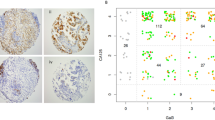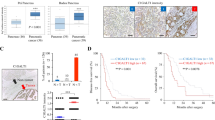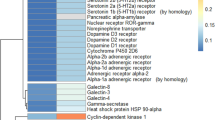Abstract
Galectin-3 (Gal-3) has been implicated in pancreatic ductal adenocarcinoma (PDAC), and its candidacy as a therapeutic target has been evaluated. Gal-3 is widely upregulated in tumors, and its expression is associated with the development and malignancy of PDAC. In the present study, we demonstrate that a polysaccharide, RN1, purified from the flower of Panax notoginseng binds to Gal-3 and suppresses its expression. In addition, RN1 markedly inhibits PDAC cells growth in vitro, in vivo and in patient-derived xenografts. Mechanistically, RN1 binds to epidermal growth factor receptor (EGFR) and Gal-3, thereby disrupting the interaction between Gal-3 and EGFR and downregulating extracellular-related kinase (ERK) phosphorylation and the transcription factor of Gal-3, Runx1 expression. Inhibiting the expression of Runx1 by RN1, suppresses Gal-3 expression and inactivates Gal-3-associated signaling pathways, including the EGFR/ERK/Runx1, BMP/smad/Id-3 and integrin/FAK/JNK signaling pathways. In addition, RN1 can also bind to bone morphogenetic protein receptors (BMPR1A and BMPR2) and block the interaction between Gal-3 and the BMPRs. Thus, our results suggest that a novel Gal-3 inhibitor RN1 may be a potential candidate for human PDAC treatment via multiple targets and multiple signaling pathways.
This is a preview of subscription content, access via your institution
Access options
Subscribe to this journal
Receive 50 print issues and online access
$259.00 per year
only $5.18 per issue
Buy this article
- Purchase on Springer Link
- Instant access to full article PDF
Prices may be subject to local taxes which are calculated during checkout







Similar content being viewed by others
References
DeSantis CE, Lin CC, Mariotto AB, Siegel RL, Stein KD, Kramer JL et al. Cancer treatment and survivorship statistics, 2014 CA Cancer J Clin 2014; 64: 252–271.
Mendelsohn J . Blockade of receptors for growth factors: an anticancer therapy—the fourth annual Joseph H Burchenal American Association of Cancer Research Clinical Research Award Lecture. Clin Cancer Res 2000; 6: 747–753.
Grant S, Qiao L, Dent P . Roles of ERBB family receptor tyrosine kinases, and downstream signaling pathways, in the control of cell growth and survival. Front Biosci 2002; 7: d376–d389.
Yamanaka Y, Friess H, Kobrin MS, Buchler M, Beger HG, Korc M . Coexpression of epidermal growth factor receptor and ligands in human pancreatic cancer is associated with enhanced tumor aggressiveness. Anticancer Res 1993; 13: 565–569.
Uegaki K, Nio Y, Inoue Y, Minari Y, Sato Y, Song MM et al. Clinicopathological significance of epidermal growth factor and its receptor in human pancreatic cancer. Anticancer Res 1997; 17: 3841–3847.
Tobita K, Kijima H, Dowaki S, Kashiwagi H, Ohtani Y, Oida Y et al. Epidermal growth factor receptor expression in human pancreatic cancer: significance for liver metastasis. Int J Mol Med 2003; 11: 305–309.
Deng H, Makizumi R, Ravikumar TS, Dong H, Yang W, Yang WL . Bone morphogenetic protein-4 is overexpressed in colonic adenocarcinomas and promotes migration and invasion of HCT116 cells. Exp Cell Res 2007; 313: 1033–1044.
Kawabata M, Imamura T, Miyazono K . Signal transduction by bone morphogenetic proteins. Cytokine Growth Factor Rev 1998; 9: 49–61.
Kleeff J, Maruyama H, Ishiwata T, Sawhney H, Friess H, Buchler MW et al. Bone morphogenetic protein 2 exerts diverse effects on cell growth in vitro and is expressed in human pancreatic cancer in vivo. Gastroenterology 1999; 116: 1202–1216.
Dumic J, Dabelic S, Flogel M . Galectin-3: an open-ended story. Biochim Biophys Acta 2006; 1760: 616–635.
Fukushi J, Makagiansar IT, Stallcup WB . NG2 proteoglycan promotes endothelial cell motility and angiogenesis via engagement of galectin-3 and alpha3beta1 integrin. Mol Biol Cell 2004; 15: 3580–3590.
Partridge EA, Le Roy C, Di Guglielmo GM, Pawling J, Cheung P, Granovsky M et al. Regulation of cytokine receptors by Golgi N-glycan processing and endocytosis. Science 2004; 306: 120–124.
Nakahara S, Oka N, Raz A . On the role of galectin-3 in cancer apoptosis. Apoptosis 2005; 10: 267–275.
Shimamura T, Sakamoto M, Ino Y, Shimada K, Kosuge T, Sato Y et al. Clinicopathological significance of galectin-3 expression in ductal adenocarcinoma of the pancreas. Clin Cancer Res 2002; 8: 2570–2575.
Kobayashi T, Shimura T, Yajima T, Kubo N, Araki K, Tsutsumi S et al. Transient gene silencing of galectin-3 suppresses pancreatic cancer cell migration and invasion through degradation of beta-catenin. Int J Cancer 2011; 129: 2775–2786.
Berberat PO, Friess H, Wang L, Zhu Z, Bley T, Frigeri L et al. Comparative analysis of galectins in primary tumors and tumor metastasis in human pancreatic cancer. J Histochem Cytochem 2001; 49: 539–549.
Blanchard H, Yu X, Collins PM, Bum-Erdene K . Galectin-3 inhibitors: a patent review (2008-present). Expert Opin Ther Pat 2014; 24: 1053–1065.
Wang P, Zhang L, Yao J, Shi Y, Li P, Ding K . An arabinogalactan from flowers of Panax notoginseng inhibits angiogenesis by BMP2/Smad/Id1 signaling. Carbohydr Polym 2015; 121: 328–335.
Barondes SH, Castronovo V, Cooper DN, Cummings RD, Drickamer K, Feizi T et al. Galectins: a family of animal beta-galactoside-binding lectins. Cell 1994; 76: 597–598.
Merlin J, Stechly L, de Beauce S, Monte D, Leteurtre E, van Seuningen I et al. Galectin-3 regulates MUC1 and EGFR cellular distribution and EGFR downstream pathways in pancreatic cancer cells. Oncogene 2011; 30: 2514–2525.
Liu W, Hsu DK, Chen HY, Yang RY, Carraway KL 3rd, Isseroff RR et al. Galectin-3 regulates intracellular trafficking of EGFR through Alix and promotes keratinocyte migration. J Invest Dermatol 2012; 132: 2828–2837.
Friedman AD . Cell cycle and developmental control of hematopoiesis by Runx1. J Cell Physiol 2009; 219: 520–524.
Zhang HY, Jin L, Stilling GA, Ruebel KH, Coonse K, Tanizaki Y et al. RUNX1 and RUNX2 upregulate Galectin-3 expression in human pituitary tumors. Endocrine 2009; 35: 101–111.
Di Lella S, Sundblad V, Cerliani JP, Guardia CM, Estrin DA, Vasta GR et al. When galectins recognize glycans: from biochemistry to physiology and back again. Biochemistry 2011; 50: 7842–7857.
Miyazono K, Miyazawa K . Id: a target of BMP signaling. Sci STKE 2002; 2002: pe40.
Liu FT, Rabinovich GA . Galectins as modulators of tumour progression. Nat Rev Cancer 2005; 5: 29–41.
Caelles C, Gonzalez-Sancho JM, Munoz A . Nuclear hormone receptor antagonism with AP-1 by inhibition of the JNK pathway. Genes Dev 1997; 11: 3351–3364.
Lopez-Bergami P, Lau E, Ronai Z . Emerging roles of ATF2 and the dynamic AP1 network in cancer. Nat Rev Cancer 2010; 10: 65–76.
Tellez-Sanz R, Garcia-Fuentes L, Vargas-Berenguel A . Human galectin-3 selective and high affinity inhibitors present state and future perspectives. Curr Med Chem 2013; 20: 2979–2990.
Sorme P, Arnoux P, Kahl-Knutsson B, Leffler H, Rini JM, Nilsson UJ . Structural and thermodynamic studies on cation-Pi interactions in lectin-ligand complexes: high-affinity galectin-3 inhibitors through fine-tuning of an arginine-arene interaction. J Am Chem Soc 2005; 127: 1737–1743.
Streetly MJ, Maharaj L, Joel S, Schey SA, Gribben JG, Cotter FE . GCS-100, a novel galectin-3 antagonist, modulates MCL-1, NOXA, and cell cycle to induce myeloma cell death. Blood 2010; 115: 3939–3948.
Chauhan D, Li G, Podar K, Hideshima T, Neri P, He D et al. A novel carbohydrate-based therapeutic GCS-100 overcomes bortezomib resistance and enhances dexamethasone-induced apoptosis in multiple myeloma cells. Cancer Res 2005; 65: 8350–8358.
Nangia-Makker P, Hogan V, Honjo Y, Baccarini S, Tait L, Bresalier R et al. Inhibition of human cancer cell growth and metastasis in nude mice by oral intake of modified citrus pectin. J Natl Cancer Inst 2002; 94: 1854–1862.
Iurisci I, Tinari N, Natoli C, Angelucci D, Cianchetti E, Iacobelli S . Concentrations of galectin-3 in the sera of normal controls and cancer patients. Clin Cancer Res 2000; 6: 1389–1393.
Ochieng J, Furtak V, Lukyanov P . Extracellular functions of galectin-3. Glycoconj J 2004; 19: 527–535.
Stegmayr J, Lepur A, Kahl-Knutson B, Aguilar-Moncayo M, Klyosov AA, Field RA et al. Low or no inhibitory potency of the canonical galectin carbohydrate-binding site by pectins and galactomannans. J Biol Chem 2016; 291: 13318–13334.
Asim M, Chaturvedi R, Hoge S, Lewis ND, Singh K, Barry DP et al. Helicobacter pylori induces ERK-dependent formation of a phospho-c-Fos c-Jun activator protein-1 complex that causes apoptosis in macrophages. J Biol Chem 2010; 285: 20343–20357.
Shin S, Asano T, Yao Y, Zhang R, Claret FX, Korc M et al. Activator protein-1 has an essential role in pancreatic cancer cells and is regulated by a novel Akt-mediated mechanism. Mol Cancer Res 2009; 7: 745–754.
Asano T, Yao Y, Zhu J, Li D, Abbruzzese JL, Reddy SA . The PI 3-kinase/Akt signaling pathway is activated due to aberrant Pten expression and targets transcription factors NF-kappaB and c-Myc in pancreatic cancer cells. Oncogene 2004; 23: 8571–8580.
Brunet A, Bonni A, Zigmond MJ, Lin MZ, Juo P, Hu LS et al. Akt promotes cell survival by phosphorylating and inhibiting a Forkhead transcription factor. Cell 1999; 96: 857–868.
Lee KS, Kim HJ, Li QL, Chi XZ, Ueta C, Komori T et al. Runx2 is a common target of transforming growth factor beta1 and bone morphogenetic protein 2, and cooperation between Runx2 and Smad5 induces osteoblast-specific gene expression in the pluripotent mesenchymal precursor cell line C2C12. Mol Cell Biol 2000; 20: 8783–8792.
Giancotti FG, Ruoslahti E . Integrin signaling. Science 1999; 285: 1028–1032.
Guo W, Giancotti FG . Integrin signalling during tumour progression. Nat Rev Mol Cell Biol 2004; 5: 816–826.
Xiao F, Qiu H, Zhou L, Shen X, Yang L, Ding K . WSS25 inhibits Dicer, downregulating microRNA-210, which targets Ephrin-A3, to suppress human microvascular endothelial cell (HMEC-1) tube formation. Glycobiology 2013; 23: 524–535.
Acknowledgements
This work was supported by grants from National Natural Science Foundation of China (31230022), New Drug Creation and Manufacturing Program (2012ZX09301001-003), Innovative Research Groups of the National Science Foundation of China (81421005), Project Funded by the Priority Academic Program Development of Jiangsu Higher Education Institutions (PAPD), Strategic Priority Research Program of the Chinese Academy of Sciences (XDA12010302).
Author information
Authors and Affiliations
Corresponding authors
Ethics declarations
Competing interests
The authors declare no conflict of interest.
Additional information
Supplementary Information accompanies this paper on the Oncogene website
Supplementary information
Rights and permissions
About this article
Cite this article
Zhang, L., Wang, P., Qin, Y. et al. RN1, a novel galectin-3 inhibitor, inhibits pancreatic cancer cell growth in vitro and in vivo via blocking galectin-3 associated signaling pathways. Oncogene 36, 1297–1308 (2017). https://doi.org/10.1038/onc.2016.306
Received:
Revised:
Accepted:
Published:
Issue Date:
DOI: https://doi.org/10.1038/onc.2016.306
This article is cited by
-
Synthesis of large polysaccharides facilitates identification of an active glycan domain
Nature Synthesis (2024)
-
Galectins and galectin-mediated autophagy regulation: new insights into targeted cancer therapy
Biomarker Research (2023)
-
Targeting galectin-driven regulatory circuits in cancer and fibrosis
Nature Reviews Drug Discovery (2023)
-
Synthesis of branched arabinogalactans up to a 140-mer from Panax notoginseng and their anti-pancreatic-cancer activity
Nature Synthesis (2023)
-
Galectin-3 in prostate cancer and heart diseases: a biomarker for these two frightening pathologies?
Molecular Biology Reports (2023)



